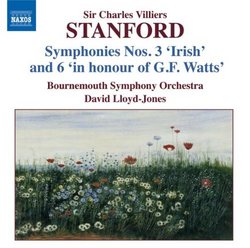| All Artists: Stanford, Lloyd-Jones, Bournemouth Symphony Orchestra Title: Sir Charles Villiers Stanford: Symphonies Nos. 3 "Irish" & 6 "In Honour of G.F. Watts" Members Wishing: 0 Total Copies: 0 Label: Naxos Original Release Date: 1/1/2008 Re-Release Date: 5/27/2008 Genre: Classical Style: Symphonies Number of Discs: 1 SwapaCD Credits: 1 UPC: 747313035571 |
Search - Stanford, Lloyd-Jones, Bournemouth Symphony Orchestra :: Sir Charles Villiers Stanford: Symphonies Nos. 3 "Irish" & 6 "In Honour of G.F. Watts"
 | Stanford, Lloyd-Jones, Bournemouth Symphony Orchestra Sir Charles Villiers Stanford: Symphonies Nos. 3 "Irish" & 6 "In Honour of G.F. Watts" Genre: Classical |
Larger Image |
CD DetailsSimilar CDs |
CD ReviewsThe Best of Stanford the Symphonist M. C. Passarella | Lawrenceville, GA | 06/26/2008 (5 out of 5 stars) "Given the price and the program, this CD provides about the best imaginable introduction to symphonic Stanford. First of all, it contains far and away Stanford's most popular symphony, No. 3, the Irish. It also contains one of his least popular, the Sixth, which lapsed into obscurity shortly after its premiere in 1905. But wait a moment: the Sixth is also conservative old Sir Charles at his most inventive and nontraditional. Not that the sound world Stanford creates is a wit beyond that you'd find in a symphony by Brahms or Max Bruch. But it has some features that show Stanford wasn't letting any moss grow on him either.
For instance, the first movement breaks forth immediately with a quirky, bounding theme with lots of off-rhythms. The first theme dominates the short movement, making it seem almost monothematic and imparting an air of nervous energy to the whole. The second movement, with its plaintive English horn melody over harp arpeggios is thus in striking contrast. More contrast with the tiny scherzo, again jumpy, almost fragmentary in nature. It has a more modern stamp to it than the rest of the symphony and leads cleverly into the finale by way of a minor-key anticipation of the finale's first theme. Trumpet flourishes also anticipate the last movement's martial nature. The aforementioned first theme is a lively march that sounds unfortunately like an up-tempo version of the hymn tune "Fairest Lord Jesus." Oh, well, Stanford is best known for his church music, so maybe he's just showing his roots here. Fueled by that march, the finale jogs along with relentless energy until, surprise, it slows to an elegiac moderato that intertwines the finale march tune with the English horn melody of the second movement, a subtle and effective approach to cyclic form. If slow endings are the kiss of death, this may explain the symphony's lack of a following over the years. But popular or not, it may be Stanford's finest. The Irish Symphony is distinguished by its melodiousness, and Stanford symphonies are short on memorable melodies generally, so this might be what sold it to audiences originally. But there is drama, too, in Stanford's working out of his themes. The first movement development section, for example, works itself to a fine pitch over the darkly potent first melody. The scherzo is a sprightly Irish jig--can't go wrong there. However, the best movement is the last, with a march-like first tune that's not only worth whistling but gives real impetus to the whole, right through to the rousing final pages. No great music here maybe. But then the best of Charles Stanford is by no means negligible, and there is much to admire in these two fine symphonies. The performances, if anything, are better than those on Volume 1, featuring Stanford's Symphonies 4 and 7. David Lloyd-Jones has the Bournemouth Symphony playing at about the top of their game, a very committed effort from all concerned. And the sound has a mutton-and-potatoes hardiness about it that suits this music well, the bass firm and robust, the brass and timpani nicely prominent throughout. " |




